| Class: | angiosperms |
| Order: | Asparagales |
| Family: | Alliaceae |
| Genus: | Allium |
| Scientific name: | Allium austrosibiricum N. Friesen |
| Name acc. to: | Gubanov 1996, not in Grubov 1982/2001 |
| Herbar: | list records   |
| Synonym: | A. senescens auct. non L.: Egorova 1977/2003, Grubov 1982/2001 (acc. to Friesen 1995) |
| Synonym: | A. spirale Willdenow (acc. to Xu Jiemei & Kamelin 2000 ) |
| Description: | Bulbs conical-cylindrical; scape 15-35 cm tall, glabrous; leaves 4-6, 1-3 mm broad (not broader than scape diameter), flat, aggregated at base of scape, much shorter than base of scape; umbel many-flowered, hemiglobose, dense; pedicels 1.5-2 times longer than perianth; perianth lobes pink, inner 1/4 longer than outer; stamen 1.5 times broader than outer; style exserted from perianth. (acc. to Friesen 1987/2001) |
| Confuse with: | A. burjaticum N. Friesen, A. dauricum N. Friesen, A. tytthocephalum Schult. et Schult. fil. |
| Comments: | A. austrosibiricum & A. dauricum: leaves 1-3 mm broad, shorter than middle of scape. A. burjaticum & A. tytthocephalum: leaves 2-4 mm broad, longer than middle of scape, often reaching inflorescense.
A. austrosibiricum: bulbs several, inflorescense hemiglobose, pedicels green. A. dauricum: bulbs 1-2, inflorescense hemiglobose to fascicular, pedicels colored (violet). |
| Link to Flora of China: | http://www.efloras.org/browse.aspx?flora_id=2&name_str=Allium+spirale |
| open map in a new window | 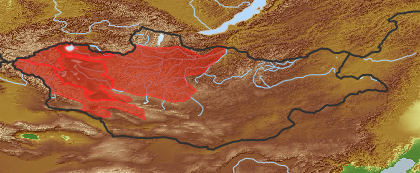 |
| Habitat: | In stony steppes (Friesen 1995). Dry slopes, steppes, stony and gravelly places, sands and loess (FOC 2000: Vol. 24). |
| Habit (i)general appearance of a plant | |
| Growth form: (i)Herb, shrub, tree or climber. | herb (i)Herbaceous, erect plant, up to 2m high, mostly with a leafy shoot; if perennial, shoots die to the ground each season, shoots are not woody
example: Artemisia pectinata   inherited by family Alliaceae: herb inherited by family Alliaceae: herb
perennial (i)Living for several to many years, as opposed to annual and biennial
acc. to: FoC online |
| Smell & Touch: (i)General appearance of the plant. | odor (i)Plant with an obvious scent  inherited by family Alliaceae: odor inherited by family Alliaceae: odor
|
| Parasite status: (i)Is the plant a half- or full parasite? | no parasite/saprophyte (i)Plant fully autonomous, leaves with chlorophyll
example: Most plants, Ranunculus  inherited by family Alliaceae: no parasite/saprophyte inherited by family Alliaceae: no parasite/saprophyte
|
| Water or terrestrial plant: (i)Where do the plants grow? | terrestrial (i)Plant grows on dry land
example: Orostachys spinosa  inherited by family Alliaceae: terrestrial inherited by family Alliaceae: terrestrial
|
| Leaf (i)expanded, usually photosynthetic organ of a plant (including phylloclades) | |
| Leaf arrangement: (i)Arrangement of leaves at the stem. | basal rosette (i)Leaves positioned at the base of the stem; stem often without leaves, no visible internodes (but flowers often on erect stems, and these may have few leaves)
example: Limonium, Potentilla, Plantago; also used in Liliales with basaly crouwded leaves (Tofieldia, Zigadenus etc.)   inherited by family Alliaceae: basal rosette inherited by family Alliaceae: basal rosette
|
| Simple or divided leaves: (i)Are the leaves simple or completely divided in several parts? Blade of the leaf entire or (more or less) deeply dissected. Attention: There are various appearances of the leaf margin (from entire to toothed and lobed). Here, we ignore this and ask only for dissections that separate the leaf for more than one third of its length or width, whatever is smaller. Sometimes, it is difficult to tell apart compound leaves from a shoot system with simple leaves: look for stipulae and/or axillary buds at the ground of the leaves: if only some possess these structures, the others are most likely leaflets of a compound leaf. | simple (i)Non-divided leaf, but margin may be incised nearly to the ground   inherited by family Alliaceae: simple inherited by family Alliaceae: simple
|
| Shape of blade: (i)Easy for simple leaves. In compound leaves use the general shape of leaflet. Always check the ground for largest leaves of a plant. To be worked out: how to handle pinnate leaves? | linear incl.grasslike or oblong (i)Leaves more than two times longer than broad with more or less parallel margins; see character: stipule for ligula
example: Dracocephalum ruyschiana, Poaceae, Scutellaria scordifolia, Pinus   inherited by family Alliaceae: linear incl.grasslike or oblong inherited by family Alliaceae: linear incl.grasslike or oblong
filiform (i)Leaves thread-like, at least more than ten times longer than broad
example: Potamogeton pectinatus, P. filiformis   inherited by family Alliaceae: filiform inherited by family Alliaceae: filiform
|
| Leaf apex: (i)Appearance of the tip of leaf resp. leaflets in compound leaves. | rounded (i)With a round apex
example: Trifolium   inherited by family Alliaceae: rounded inherited by family Alliaceae: rounded
obtuse (i)Sides coming together at the apex at an angle greater than 90 degrees
example: Fallopia convolvulus   inherited by family Alliaceae: obtuse inherited by family Alliaceae: obtuse
|
| Leaf margin: (i)Structure of leaf margin (or that of a leaflet in case of compound leaves). Attention: Here we ask for the leaf margin, defined as all those dissections that separate the leaf for less than one third of its length or width, whatever is smaller. To be worked out: how to handle margin of pinnate leaves? | entire (i)Plain margin, not toothed
example: Iris   inherited by family Alliaceae: entire inherited by family Alliaceae: entire
|
| Petiole: (i)Leaf divided into stalk (petiole) and blade. | without (i)Leaves without petiole (stalk), sessile
example: Poaceae, Iris 
|
| Stipule: (i)Leaflets at the base of the petiole, these are smaller and of different shape. | none (i)Without stipules
example: Euphorbia, Ericaceae s.l.  inherited by family Alliaceae: none inherited by family Alliaceae: none
|
| Leaf colour upper side: (i)Shades of green on the leaf, upper side. | green (i)Clear green
example: Tribulus terrestris  inherited by family Alliaceae: green inherited by family Alliaceae: green
|
| Leaf colour lower side: (i)Shades of green on the leaf, lower side. | green (i)Clear green, in most species
example: Angelica decurrens  inherited by family Alliaceae: green inherited by family Alliaceae: green
|
| Leaf veination: (i)Arrangement of the main veins of a leaf. | parallel (i)Most veins arranged parallel to the length of leaf, mostly no pronounced main vein (usually in elongate to linear leaves)
example: Most Monocotyledonae, Plantago, Veratrum, a lot of Caryophyllaceae looks like that.   inherited by order Asparagales: parallel inherited by order Asparagales: parallel
|
| Flower (i)reproductive portion of the plant, consisting of sepals, petals, stamens, and pistils | |
| Flower appearance and pollination: (i)General appearance of the flower. | attractive, animal-pollinated (i)attractive and coloured flowers, mostly large, attracting surely animals
example: Trollius, Rosa, Chamaerhodos  inherited by family Alliaceae: attractive, animal-pollinated inherited by family Alliaceae: attractive, animal-pollinated
|
| Perianth arrangement: (i)Attention: in some plants, flowers may be dimorphic in different ways (dioecious or gynodioecious). If flowers vary, record the characters of the most showy flowers. | simple, similar (i)Only one type of perianth leaves (tepals)
example: Tulipa   inherited by family Alliaceae: simple, similar inherited by family Alliaceae: simple, similar
|
| Diameter of flower: (i)Diameter of flower or flower head. | to 5 mm (i)
example: Aruncus  inherited by family Alliaceae: inherited by family Alliaceae:
from 5 mm to 10 mm (i)
example: Stellaria  inherited by family Alliaceae: inherited by family Alliaceae:
|
| Flower symmetry: (i)Symmetry of the perianth leaves. Attention: to assess this character, look on sepals, petals and stamens, but neglect carpels and ovary. | radiary, regular (actinomorphic) (i)More than two axis of symmetry
example: Saxifraga: 5; Iris: 3   inherited by family Alliaceae: radiary, regular (actinomorphic) inherited by family Alliaceae: radiary, regular (actinomorphic)
|
| Flower form: (i)common forms of flowers ? Veronica | simple (flat) - Do not confuse with inflorescences as in some Asteraceae (i)Petals spread out, flower appearing flat
example: Mollugo, Trientalis, Pulsatilla, Saxifraga   inherited by family Alliaceae: simple (flat) - Do not confuse with inflorescences as in some Asteraceae inherited by family Alliaceae: simple (flat) - Do not confuse with inflorescences as in some Asteraceae
|
| Sepal number: (i)Number of sepal leaves (outer perianth leaves, calyx leaves, mostly greenish). Attention, this character applies only for flowers separated in sepals and petals, thus excluding most monocots. Be aware of the bracts (involucral leaves) of Asteraceae flowerheads, do not qualify these as sepals! Be also aware in Rosaceae is often an epicalyx developed, in this case count all parts. | none or rudimentary (i)Hardly visible or absent, since perianth uniform
example: All monocots with uniform perianth, many Asteraceae and Apiaceae  inherited by family Alliaceae: none or rudimentary inherited by family Alliaceae: none or rudimentary
|
| Petal / Tepal number: (i)Number of petal leaves (inner perianth leaves, usually coloured). | 6 (i)
example: Allium, Lilium, Dactylorhiza  inherited by family Alliaceae: 6 inherited by family Alliaceae: 6  inherited by genus Allium: 6 inherited by genus Allium: 6
|
| Petal / Tepal fusion: (i)To which degree are the petal leaves connected? Petals sympetalous. | fused at base (i)petal leaves with a joint base, but fused over not more than 50% of the entire length
example: Myosotis, Pedicularis, Cortusa  inherited by family Alliaceae: fused at base inherited by family Alliaceae: fused at base
|
| Spur: (i)A hollow, slender, sac-like appendage of the perianth leaves, storing nectar. | no spur (i)Flower without appendage
example: Peganum  inherited by family Alliaceae: no spur inherited by family Alliaceae: no spur
|
| Stamen number: (i)Attention: We ask for the reproductive organs of the flower dispersing pollen. Count only fully fertile stamens, not staminodia (e.g. Parnassia). | 6 (i)
example: Veratrum, Smelowskia, Juncus  inherited by family Alliaceae: 6 inherited by family Alliaceae: 6
|
| Stamen fusion: (i)To which degree are the stamens fused? Attention: Whereas the pollen sacs itself are often free., their stalks (filaments) may be fused. Here, we count them as fused if they are together over at least one thirth of their length. | free (i)Stamens with separate bases
example: Malus  inherited by family Alliaceae: free inherited by family Alliaceae: free
fused with each other (i)All or most stamens fused with each other to a tube-like structure
example: Caragana, Petasites  inherited by family Alliaceae: fused with each other inherited by family Alliaceae: fused with each other
|
| Pistil number: (i)Number of pistils (female floral organs: style, if developed; stigma and carpels/ovary together build the pistil). | 1 (i)One carpel, but clearly one stigma
example: Pyrola, Primula, Alyssum  inherited by family Alliaceae: 1 inherited by family Alliaceae: 1
3 (i)Three stigmas, usually in a triangle
example: Stellaria, Euphorbia, Campanula, Allium  inherited by genus Allium: 3 inherited by genus Allium: 3
|
| Carpel fusion: (i)To which degree are the carpels (modified leaf forming simple pistil or part of a compound pistil) fused. | fused (i)Carpels united into an ovary, only styles are free
example: Malus, Berberis  inherited by family Alliaceae: fused inherited by family Alliaceae: fused
|
| Style number: (i)Portion of the pistil connecting the stigma to the ovary. | 1  inherited by family Alliaceae: 1 inherited by family Alliaceae: 1
|
| Ovary position: (i)For entirely or partly fused carpels, describe their position in relation to the insertion point of perianth leaves (best done by doing a longitudinal section of a flower). | superior (hypogynous) (i)Base of carpels attached above insertion point of perianth leaves, carpels free or fused
example: Delphinium, Anemone    inherited by family Alliaceae: superior (hypogynous) inherited by family Alliaceae: superior (hypogynous)
|
| Sex: (i)Distribution of male and female organs among flowers, only most commonly cases. | bisexual, hermaphrodite (i)All or nearly all flowers of a plant with male and female parts
example: Haplophyllum, Chenopodium  inherited by family Alliaceae: bisexual, hermaphrodite inherited by family Alliaceae: bisexual, hermaphrodite
|
| Inflorescence (i)flowering part of a plant, describes the arrangement of the flowers on the flowering axis | |
| Inflorescence: (i)Structure of the inflorescence. | Flowers in inflorescence (i)No solitary flowers  inherited by family Alliaceae: Flowers in inflorescence inherited by family Alliaceae: Flowers in inflorescence
Simple inflorescences (i)Flowers sessile on a main shoot or on short to long not branched side shoots
example: Polygonum bistorta    inherited by family Alliaceae: Simple inflorescences inherited by family Alliaceae: Simple inflorescences
|
| Appearance: (i)Outer look of the inflorescence. | terminal (i)Inflorescence is the highest point of the plant and may consist of a single flower only
example: Cypripedium, Rhaponticum, Ligularia sibirica, Echinops  inherited by family Alliaceae: terminal inherited by family Alliaceae: terminal
|
| Inflorescence type: (i)Types of inflorescence. Attention: We here ask for the botanical nomenclature of inflorescences, which is sufficiently complicated. Tick only, if you are certain, or tick all inflorescence types that appear similar of these of the plant in question. | umbel (i)Flowers on short to long, leafless stalks emerging from one point
example: Allium   inherited by family Alliaceae: umbel inherited by family Alliaceae: umbel
|
| Fruit (i)the seed bearing organ, with or without adnate parts; a ripened ovary and any other structures which are attached and ripen with it. Aggregate fruits are handled like simple fruits for determination. | |
| Consistency: (i)Fleshy fruits or dry fruits, see dispersal adaptations for further classification. | dry (i)With a dry outer shell, no fleshy parts, but seed (embryo) could be edible  inherited by family Alliaceae: dry inherited by family Alliaceae: dry
|
| Type of fruit: (i)Common fruit types (including pseudocarp). | Solitary fruits (i)     inherited by family Alliaceae: Solitary fruits inherited by family Alliaceae: Solitary fruits
capsule (i)Dry dehiscent fruit, releasing seeds by slits or holes.
example: Poppy, most Caryophyllaceae, Cerastium, a lot of Scrophulariaceae, Iris (oppened capsule looks like Delphinium), Zygophyllum - it is a very common fruit type     inherited by family Alliaceae: capsule inherited by family Alliaceae: capsule
Dehiscent fruits (i)Fruits open along a longitudinale line (except silicula)  inherited by family Alliaceae: Dehiscent fruits inherited by family Alliaceae: Dehiscent fruits
|
| Opening of fruit: (i)Mode of dehiscence at maturity to release seeds. | opening along dehiscent line (i)Opening along a preformed line
example: Vicia, Lathyrus: pods  inherited by family Alliaceae: opening along dehiscent line inherited by family Alliaceae: opening along dehiscent line
opening / dehiscent (i)Dry? Fruits opening with different types  inherited by family Alliaceae: opening / dehiscent inherited by family Alliaceae: opening / dehiscent
|
| Size of fruit: (i)Size of the fruit including appendage. | to 5 mm (i)
example: Halerpestes: many folicles forming dry nutlets  inherited by family Alliaceae: inherited by family Alliaceae:
from 5 mm to 10 mm (i)
example: Silene: small capsule opening with teeth  inherited by family Alliaceae: inherited by family Alliaceae:
|
| Seed number: (i)Estimate the number of seeds per fruit, if recognizable seeds are in the fruit (in rare cases a fruit may contain one seeded nuts: rose hip, carex). | 2-6 (i)2-6 single seeds, well recognizable
example: Crataegus: few-seeded berry  inherited by family Alliaceae: 2-6 inherited by family Alliaceae: 2-6
|
| Hairs | |
| Has hairs?: | no hairs, glabrous  inherited by family Alliaceae: no hairs, glabrous inherited by family Alliaceae: no hairs, glabrous
|
| Shoot/Stem (i)a young stem or branch | |
| Spines, thorns or prickles: (i)Shoot with conspicuous spines, thorns or prickles. | absent (i)Stem glabrous or hairy, but never with spines, thornes or prickles
example: Gentiana barbata  inherited by family Alliaceae: absent inherited by family Alliaceae: absent
|
| Root / shoot below ground (i)plant part below ground (in most cases), including below ground shoots, without leaves | |
| Root type: (i)Organisation of the roots. | homorhizous (i)Many equal roots
example: Monocotyledonae  inherited by order Asparagales: homorhizous inherited by order Asparagales: homorhizous
many equal roots (homorhizous or creeping rhizome) (i)Monocotyledons and dicotyledons with creeping rhizomes and roots of nearly equal diameter
example: Stipa  inherited by family Alliaceae: many equal roots (homorhizous or creeping rhizome) inherited by family Alliaceae: many equal roots (homorhizous or creeping rhizome)
|
| Storage in below-ground structures: (i)Rhizomes or bulbs. | bulbs with roots on lower side (i)Leaves at the base of the plant form a bulb, containing one to many leaves
example: Lilium, Allium, Gagea  inherited by family Alliaceae: bulbs with roots on lower side inherited by family Alliaceae: bulbs with roots on lower side  inherited by genus Allium: bulbs with roots on lower side inherited by genus Allium: bulbs with roots on lower side
|
| Distribution (i)region where the plant is likely to be found | |
| Distribution (Veg. Zones): (i)acc. to Grubov 1952 | Khangai (i)In distribution data often named as '3' 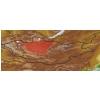
Khobdo (i)In distribution data often named as '6' 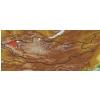
Mongolian Altai (i)In distribution data often named as '7' 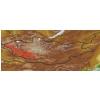
Depression of Great Lakes (i)In distribution data often named as '10' 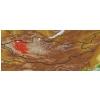
acc. to: Gubanov 1996 |
| Distribution Khangay: (i)acc. Flora Khangaya 1989 | II
|
| Plant Use | |
| Medical Plant Use: (i)Only if plant is used as medical plant | Ingredients: the bulbs contain spirostanol saponins (i)Medically effective ingredients
acc. to: Phytochemistry. 1995 Sep;40(2):521-5. |
| General Use: | forage plant (i)This plant is known as forage plant (Johnson 2003)  inherited by family Alliaceae: forage plant inherited by family Alliaceae: forage plant
medical plant  inherited by family Alliaceae: medical plant inherited by family Alliaceae: medical plant
|